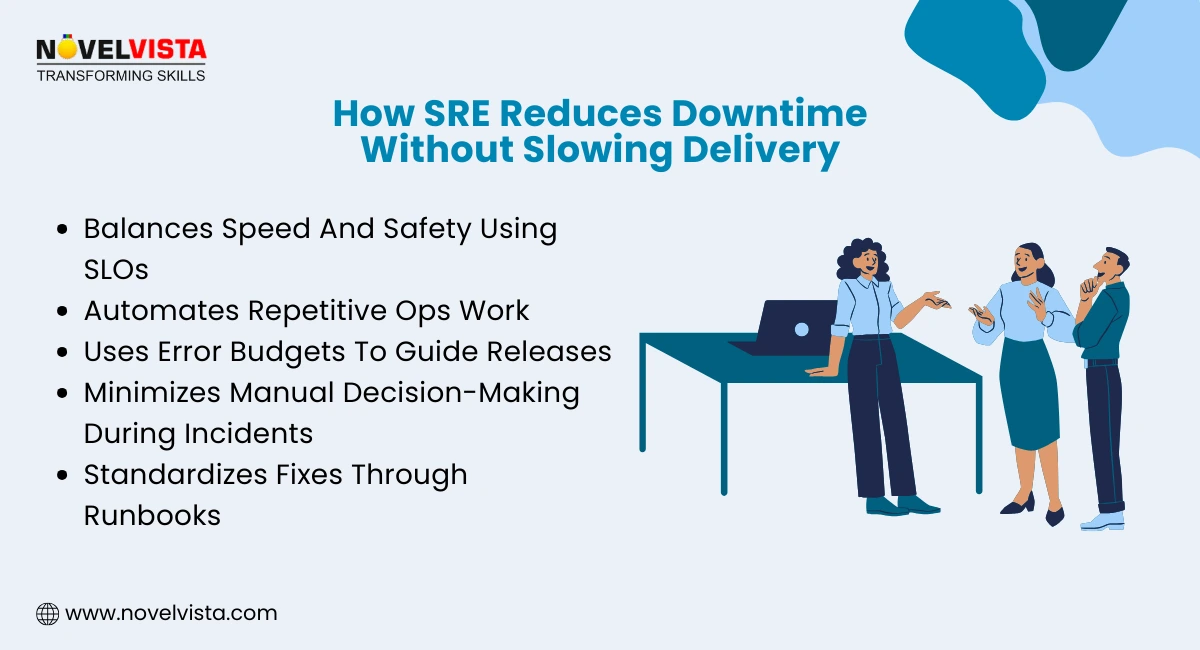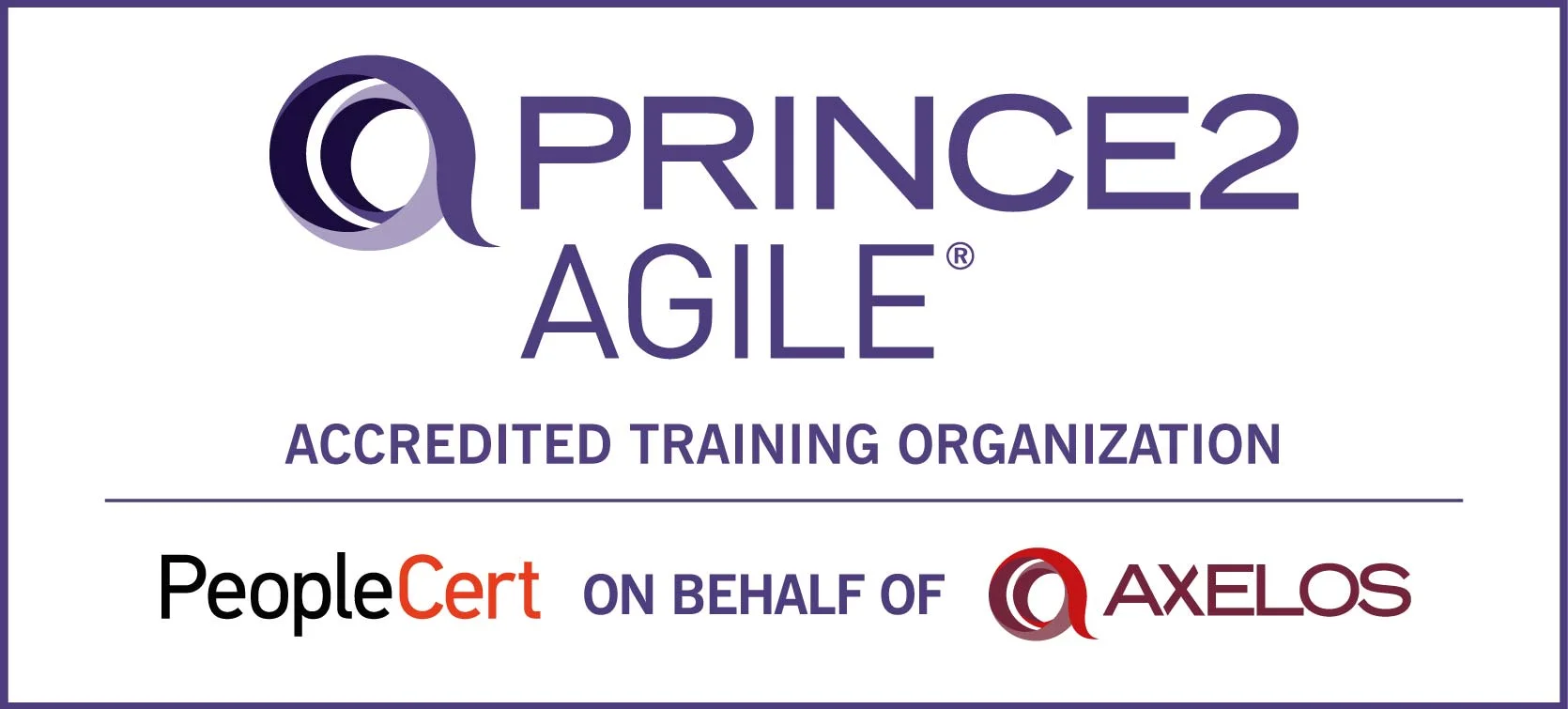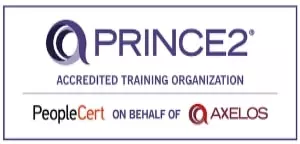- Why SRE Practices Are Essential to Adopt
- Core Principles Behind Effective SRE Practices
- SLIs, SLOs & Error Budgets: Foundation of SRE Best Practices
- SRE Monitoring Best Practices & Observability Essentials
- SRE Incident Management Best Practices
- Release Engineering & Change Reliability
- Capacity Planning & Performance Engineering
- Toil Reduction & Automated SRE Best Practices Implementation
- What Tools Support Modern SRE Practices?
- Security, Compliance & Reliable Systems
- Reliability by Design: Simplicity & Architecture
- SRE Culture & Shared Ownership Across Teams
- How Individual Engineers Can Get Started
- Conclusion
When your app slows down right when users need it most, or a small deployment quietly breaks five other services, it feels less like a glitch and more like a warning sign. Teams often end up juggling speed and stability without a clear way to balance both. That’s exactly where SRE best practices bring clarity. Instead of relying on guesswork or reacting after things fail, SRE gives you a practical way to measure reliability, control risk, and automate the messy parts of operations.
This blog breaks down what SRE really is, why it matters for modern engineering teams, and how you can use it to keep your systems dependable even as everything around them moves fast.
Why SRE Practices Are Essential to Adopt
Modern systems break in ways that are sudden, unpredictable, and often hard to trace. As teams move toward microservices, rapid deployments, and cloud-native setups, traditional operations start falling behind. Here’s why SRE practices become essential:
- They replace guesswork with clarity: Reliability targets help teams understand how much risk is acceptable, where to focus, and how to balance user experience with engineering speed.
- They create better alignment between teams: SRE gives product, engineering, and business teams a common language to prioritize what truly matters for users.
- They improve visibility into system behavior: With metrics, logs, and traces working together, teams can spot issues early and understand the real cause instead of reacting blindly.
- They reduce operational stress through automation: Repetitive tasks, deployments, rollbacks, monitoring, and incident response become automated, consistent, and far less error-prone.
- They make systems more resilient as you scale: SRE transforms reliability into a measurable, manageable practice instead of constant firefighting.
- They lead to a calmer, more predictable on-call experience: Fewer noisy alerts and faster recovery mean engineers can actually focus on building, not just fixing.
For any team looking to scale without chaos, SRE practices provide the structure, confidence, and stability needed to grow smoothly.
Core Principles Behind Effective SRE Practices
At the heart of SRE is a practical idea: systems can run more smoothly when teams plan for reliability instead of reacting later. Modern teams focus on clear reliability goals that guide smarter decisions and healthier systems. Instead of chasing unrealistic perfection, they use data to understand risk, improve performance, and keep services steady as they grow. These SRE practices help teams maintain a strong balance between rapid delivery and dependable operations..
The mindset shifts from manual work to engineering-led operations.
Teams use:
- automation to remove repeated tasks,
- measurable indicators instead of assumptions,
- and data-driven choices to decide where to spend time.
This gives everyone, from developers to platform teams, a shared way to talk about reliability.
SLIs, SLOs & Error Budgets: Foundation of SRE Best Practices
SLIs (Service Level Indicators) are the numbers that tell you if users are happy, things like latency, uptime, and error rate.
SLOs (Service Level Objectives) define the goal, like “99.9% of requests must be successful.”
Error budgets show how much unreliability you can allow before you must slow down deployments.

These aren’t just fancy terms. They shape product decisions.
- If the error budget is healthy → teams can ship fast.
- If it runs out → teams focus on fixes instead of features.
This structure is part of SRE best practices because it protects the user experience without blocking innovation.
To explore these concepts in detail with examples and best practices, head over to our complete SLA, SLI, and SLO explainer.SRE Monitoring Best Practices & Observability Essentials
Good monitoring should focus on what users care about, not every tiny metric on every dashboard. That’s why SRE promotes the “golden signals”:
- Latency – Measures how long requests take. Spikes often point to overloaded services, slow dependencies, or code issues affecting user experience.
- Errors – Tracks failed or incorrect requests. Helps teams spot outages, misconfigurations, deployment issues, or unexpected system behaviors early.
- Traffic – Shows how many requests your system receives. Useful for capacity planning and detecting unusual surges or drops in usage patterns.
- Saturation – Indicates how close your system is to resource limits. Helps prevent bottlenecks and performance degradation before users feel the impact.
These work as a simple window into system health.
Using SRE monitoring best practices, teams build a unified observability setup where metrics, logs, and traces work together. Alerts are not random; they guide you to take action.
Observability helps teams understand why something broke instead of just seeing that it did. This leads to faster fixes, fewer noisy alerts, and a much calmer on-call experience.
SRE Best Practices' Common Mistakes & Fixes Cheat Sheet
Avoid the mistakes that slow SRE teams down.
Learn quick, practical fixes to improve reliability, speed,
and on-call peace of mind.
SRE Incident Management Best Practices
When something fails, chaos makes things worse. That’s why SRE incident management best practices rely on structure. Every major outbreak gets a clear owner, an Incident Commander who coordinates recovery.
A good incident process uses:
- severity definitions
- quick communication
- solid runbooks
- and a focus on restoring service fast.
After things are stable, teams hold a blameless postmortem. Instead of pointing fingers, they ask: “What broke? Why? How do we make sure it doesn’t happen again?” This builds trust and long-term reliability.
Release Engineering & Change Reliability

Smaller, automated releases reduce downtime and lower risk. SRE promotes continuous delivery, where every change moves through automated tests and pipelines.
Teams also rely on smart rollout strategies:
- canary deployments to test changes on a small set of users,
- blue-green deployments to switch traffic safely,
- and progressive rollouts that pause if errors rise.
SLOs and error budgets help teams decide if a release is safe to continue. This setup aligns release speed with user experience—one of the most important SRE practices in modern engineering.
Capacity Planning & Performance Engineering
Systems often fail not because of bugs, but because they can’t handle the load. Capacity planning fixes that. It involves forecasting future usage and giving systems enough headroom to stay stable even when demand spikes.
Good planning includes:
- load testing
- performance baselines
- auto-scaling rules
- resilience patterns like graceful degradation
These steps protect apps during peak traffic. This area is also tied to SRE best practices because it reduces surprise failures and keeps services smooth.
Toil Reduction & Automated SRE Best Practices Implementation
If there’s one thing that quietly eats up engineering time, it’s toil—repeated manual work that doesn’t add long-term value. SRE aims to shrink this as much as possible so teams can focus on building the future instead of fixing the past.
Toil is anything like restarting stuck jobs, updating configs manually, or doing the same steps every time an alert fires. When teams adopt automation, these tasks stop being headaches.
This is where automated SRE best practices implementation helps. Teams use:
- Infrastructure as Code (IaC) to set up cloud resources predictably
- self-service internal tools so developers solve common tasks without waiting
- auto-remediation rules to fix known issues instantly
- policy-as-code to enforce rules without manual checks
This brings stability and frees engineers to work on improvements rather than routine fixes.
Want to dig deeper into cutting repetitive work? Check out our full guide on How to Reduce Toil to a Minimum for practical steps and real examples.What Tools Support Modern SRE Practices?
Many people ask: What tools support modern SRE practices? The truth is, there’s no single tool. Instead, teams combine a set of platforms that work together to support reliability.
Here’s a simple breakdown:
Observability Tools
Help you understand what’s happening inside the system.
Examples: metrics dashboards, tracing tools, log platforms.
Incident Response Tools
Help manage outages smoothly.
Examples: on-call schedulers, alert routers, communication tools.
Deployment & Release Tools
Help automate rollouts and improve change stability.
Examples: CI/CD pipelines, progressive delivery tools.
Infrastructure & Automation Tools
Help reduce toil and standardize environments.
Examples: IaC tools, configuration managers, workflow engines.
When these connect with each other, teams build a closed-loop system, detect issues fast, fix them fast, and deploy with confidence. This is why answering what tools support modern SRE practices? always leads back to one idea: integration is more important than the tool itself.
Security, Compliance & Reliable Systems
Reliability and security go hand in hand. A system isn’t truly reliable if it’s easy to compromise. SRE focuses on simple, practical habits that keep both stability and safety in check.
This includes:
- using least privilege for all services
- applying secure defaults across configs
- automating compliance checks
- scanning images and code in pipelines
- keeping audit logs clean and consistent
SRE also helps set clear configuration baselines so teams don’t drift into risky setups. This structure reduces security surprises and keeps services reliable under pressure.
Reliability by Design: Simplicity & Architecture
Complex systems break more often. That’s why one of the strongest SRE habits is keeping things simple, fewer moving parts, fewer unknowns, fewer failures.
Good architecture supports reliability through patterns like:
- retries with backoff
- timeouts
- bulkheads to isolate failures
- caching
- rate limits
- circuit breakers
These patterns reduce blast radius and keep apps stable even when things go wrong. Clear ownership also matters. When teams know who owns what, they avoid confusion during outages and keep services healthy.
How Individual Engineers Can Get Started
You don’t need a special title to apply SRE practices. Anyone can start with a few simple steps:
- Learn how to define SLIs and SLOs for your service
- Start measuring what users actually feel
- Build small automations for repeated work
- Write short runbooks for common issues
- Practice blameless reviews when something breaks
- Explore observability tools and experiment with alerts
For those who want structured learning, NovelVista’s SRE Foundation and SRE Practitioner certifications help build strong, real-world skills using modern SRE best practices. These courses guide you with hands-on knowledge, practical examples, and industry-ready methods that match how today’s teams work.
Conclusion
SRE brings a simple promise: build systems that stay steady while still moving quickly. By following SRE practices, teams get better clarity, smoother releases, cleaner alerts, and a calmer on-call life. Whether it’s monitoring, incident handling, automation, or architecture, each habit adds up to a more reliable service and a more confident engineering team.
Next Step:
If you want to grow your reliability skills the right way, NovelVista’s SRE Foundation and Practitioner programs are the best place to start. The training is practical, beginner-friendly, and aligned with how modern teams work. You learn real-world methods, tools, examples, and habits used globally. Whether you're a developer, engineer, or team lead, this is your quickest path to applying SRE with confidence.
Frequently Asked Questions
Author Details

Vaibhav Umarvaishya
Cloud Engineer | Solution Architect
As a Cloud Engineer and AWS Solutions Architect Associate at NovelVista, I specialized in designing and deploying scalable and fault-tolerant systems on AWS. My responsibilities included selecting suitable AWS services based on specific requirements, managing AWS costs, and implementing best practices for security. I also played a pivotal role in migrating complex applications to AWS and advising on architectural decisions to optimize cloud deployments.
Confused About Certification?
Get Free Consultation Call









